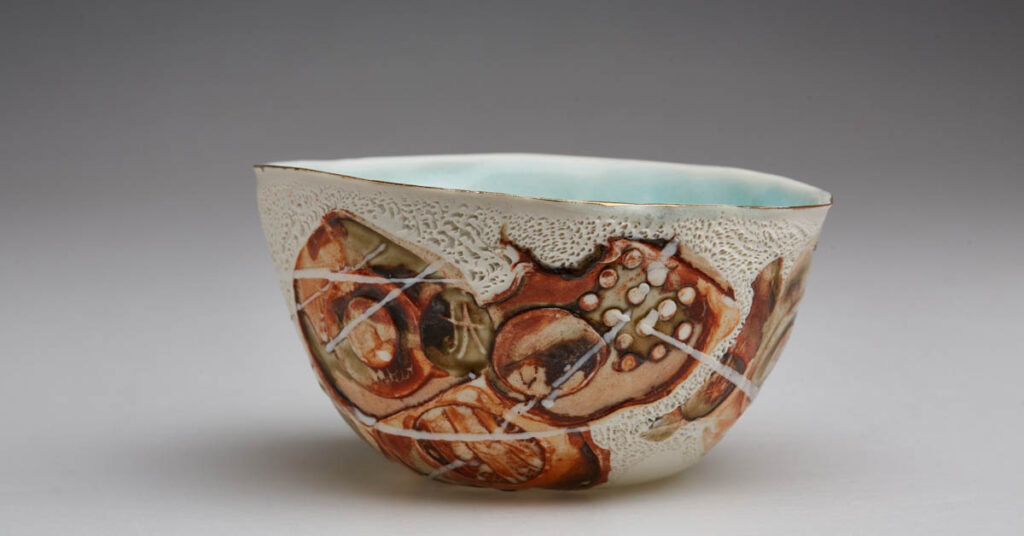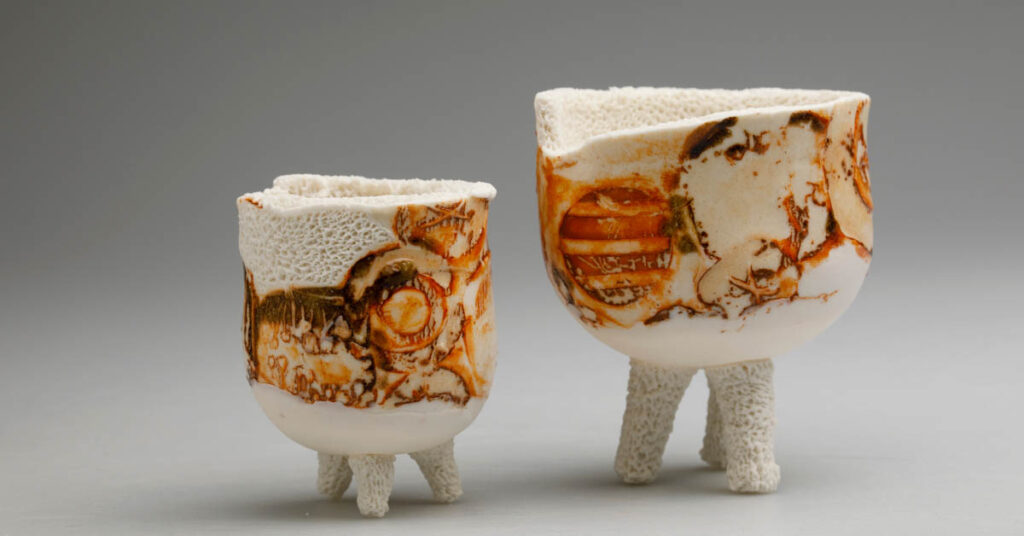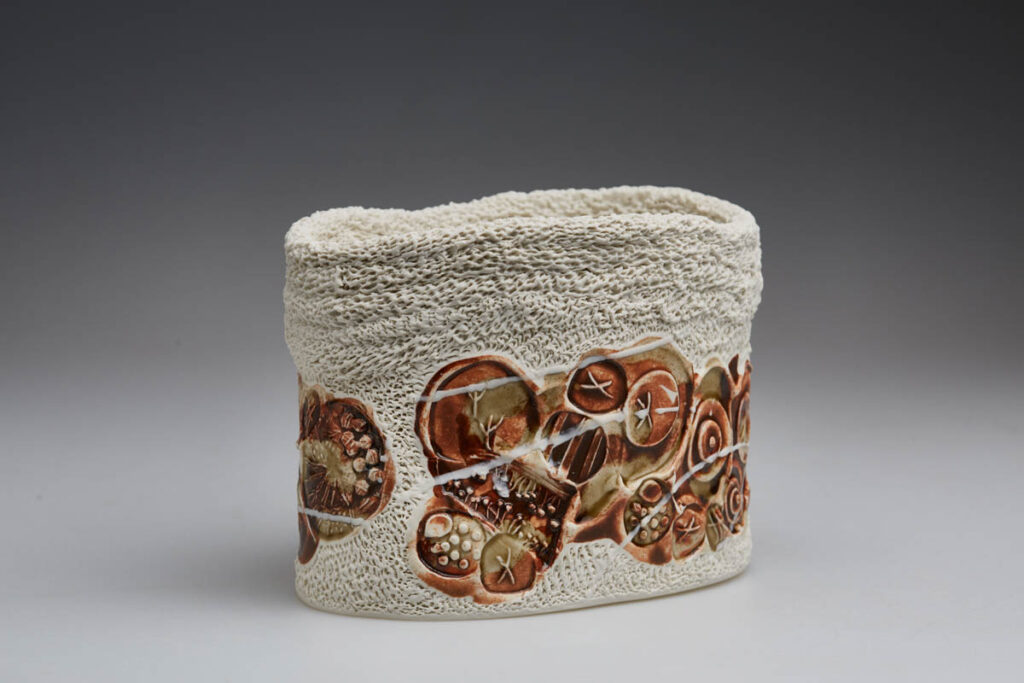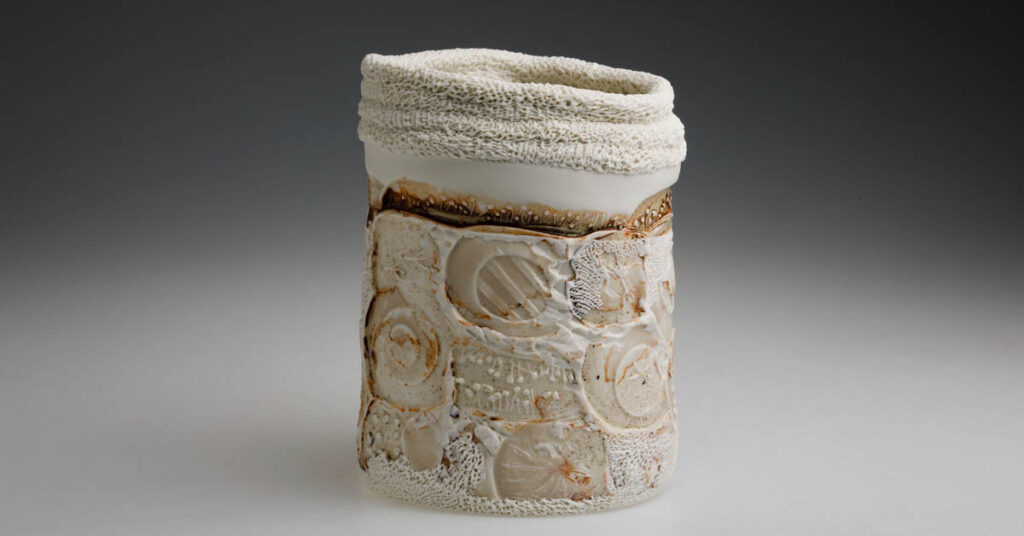
Avi Amesbury, The land speaks No.2, 2022, Porcelain, blue glaze, gold lustre, H80 x W140 x D155 mm, Photography Art Atelier.
Julie Bartholomew reviews a sensory exhibition of ceramics that connects us to sand, seaweed, ash and other planetary materials.
We are all capable of bringing memory or meaning to a place, and this engagement can heighten the significance of a location associated with our past experiences or current surroundings. For a craft-based artist who sources raw materials from the earth to incorporate into their practice, the threads of connection between hand-formed items and their places of origin are like magnetic circuits that charge the material object with vitality and meaning.
As an audience, we are invited to experience these objects of inspiration, But without devices that encourage engagement, disclosure of intent may be allusive, often remaining dormant and undiscovered. Avi Amesbury’s exhibition, Connections – land and sea at Makers Gallery in Brisbane, gently coaxes an acquaintance between the viewer and objects by incorporating informative titles, verse, and the sounds of birds, frogs, wind, rain, sea, and voice. Each piece reveals distinct physical features because each work responds to place, in this instance, the fluid juncture between land and sea at Barragga Bay on New South Wales’ South Coast, where Amesbury has lived since 1992.

Avi Amesbury, Holding Earth No1 & No2, 2022, Porcelain, found clay, Dimensions variable, Photography Art Atelier
Familiarity with Amesbury’s hand-crafted objects is encouraged in other ways. Grasping, lifting, cupping-in-hand and rotating vessels from this series provide clues to the ideas surrounding the new work. Running one’s fingers across tiny repetitive holes incised into the surface of creamy porcelain evokes associations with the spongy foam created by the sea’s ceaseless movement or bleached coral. A blue glaze covering the interior of a selection of bowls conveys a more direct reference to the sea, depicting the fluctuation of colour in the ocean at different times of day. Rich terra cotta variations are fused into the same vessels over imprints from stamps carved in response to impressions of the Barragga Bay land and seascape. The discovery of these dichotomous but interconnected components speaks to the convergence of land and sea.
Amesbury’s collection of samples from various locations, destined to be entwined within the porcelain structure of her forms, reinforces the value of inanimate coloured clays, pigments, oxides, sand, seaweed, ash and other earth and sea fragments. Her use of white porcelain appears to be the bones or substructure of her practice rather than the essence. These samples, gleaned from suasive locations and then fused into vessel forms, authenticate and activate each piece.

Avi Amesbury, Moving-darkening skies, 2022, Porcelain, found clay, clear glaze, H150 x W210 x D140 mm, Photography Art Atelier
An acquaintance with these intimate vessels through sight, touch, and the accompanying verse and sound reveals an intention that appears to be more expansive and complex than a direct response to the juncture of land and sea. Amesbury’s exhibition acknowledges a vital cognisance that arises from the troubling interaction of humans and the natural environment.
With this in mind, it should come as no surprise that during the development of the new series, Amesbury was well aware of the unsettling interaction that exists between humans and the natural world, having experienced the Black Summer fires of 2019 and 2020, a consequence of extraordinarily dry and catastrophic conditions, fuelled by climate change. Memories Held, a section of verse that accompanies the exhibition, is a lament for humans’ frayed and tenuous relationship with the land that absorbs our imprint. As our epoch’s climate crisis continues to devastate irreplaceable habitat, these words express concern for the disappearance of both land and memories.

Avi Amesbury, Colours of sand, 2022, Porcelain, found clay, clear glaze, H200 x W75 x D75 mm, Photography Art Atelier
More than a century has passed since the Arts and Crafts Movement was founded by William Morris, who was inspired by John Ruskin’s “… radical critique of some of the central values of Western civilisation.” The movement’s intellectual core was acutely aware of the possibilities for an ecologically viable culture with ties to a physical location and its complex animate and inanimate interrelationships.
Ceramics and other craft practices have inherited this historical legacy, which resonates today as we face a deteriorating eco-system. Add to this critical tradition craft characteristics such as an ongoing dialogue between maker, object, material, process, and place, and you have practices that navigate interrelationships and draw attention to our material home with its complex and finely tuned eco-system.
Avi Amesbury’s contribution is Connections-land and sea, and she joins a growing number of artists who are emphasising materiality and looking outwards in order to forge meaningful relationships with their external material world while raising awareness of environmental issues and the need for social change.
✿
Dr Julie Bartholomew is an artist, educator and writer based in Sydney.
Follow @juliebartholomewceramics and visit www.juliebartholomew.com.

